Parboiling
Parboiling (from partially boiled) is an industrial process of treating rice (end product parboiled rice ) or other grains (see pearl barley ). Around a fifth of the world's rice production is processed into parboiled rice.
Manufacturing
To make parboiled rice, paddy rice , which is still surrounded by husks , is first soaked in several steps, then treated with hot steam , then dried and only then peeled and polished.
If the rice is not pretreated by steaming and drying as in the conventional parboiling process, but by pressure and vacuum processes, then the rice is referred to as converted rice .
properties
Through the parboiling process, around 80 percent of the vitamins and minerals contained in the silver skin are pressed into the interior of the rice grain. As a result, parboiled rice is nutritionally more valuable than peeled white rice and also has better structural properties (higher dextrin and lower amylose content ). Cooked parboiled rice has a slightly stronger taste due to its content of flavor precursors . Compared to whole grain rice, parboiled rice has a shorter cooking time.
During the parboiling process, the surface of the rice grains is gelatinized by the starch it contains . This significantly reduces the percentage of breakage when grinding the grains.
Parboiled rice is slightly yellow in color, but disappears when cooked. The parboiling process makes the cooked rice firmer and less sticky. For this reason, parboiled rice is not suitable for certain dishes such as risotto or sushi .
history
Shortly before the outbreak of the First World War, the German-British inventor Erich Huzenlaub (1888–1964) developed the first parboiling process in the 1910s, also known as the Huzenlaub Process in the English-speaking world . Then the entrepreneur Gordon Harwell (director of Converted Rice Inc., the forerunner of Uncle Ben’s ) developed another method of parboiling.
Schematic representation of the parboiling process
The enlarged section symbolically shows the vitamins and minerals contained in the silver skin .
Comparison of the ingredients
Figures in mg / 100 g of consumable substance
| ingredient | Brown rice | polished rice | Parboiled rice |
|---|---|---|---|
| Vitamin B 1 | 0.4 | 0.06 | 0.5-1.0 |
| niacin | 5.4 | 1.6 | 4.7 |
| Vitamin E. | 1.5 | traces | 0.8 |
Note: Raw rice contains around 40% husks that are removed in the husk mill .
Based on an FAO resolution, the vitamin B 1 content of ground rice in South and East Asia should be at least 0.18 mg / 100 g. Without an enrichment process (e.g. parboiling), this requirement could not be met.
See also
literature
- Hans-Albert Kurzhals (Ed.): Lexicon of food technology. Volume 2. Behr's Verlag, Hamburg 2003, ISBN 978-3-86022-973-6 , article Parboiling .
Individual evidence
- ↑ a b c Waldemar Ternes , Alfred Täufel, Lieselotte Tunger, Martin Zobel (ed.): Food Lexicon . 4th, comprehensively revised edition. Behr, Hamburg 2005, ISBN 3-89947-165-2 .
- ↑ EUU Ituen, AC Ukpakha (2011). Improved method of par-boiling paddy for better quality rice. World Journal of Applied Science and Technology, Vol. 3, No. 1 (2011). Pp. 31-40





